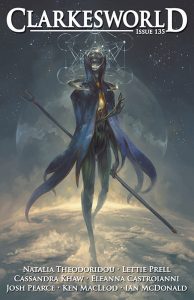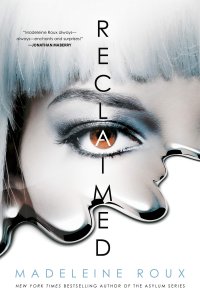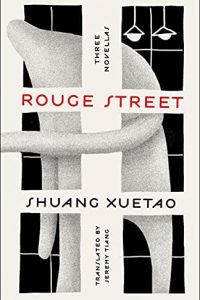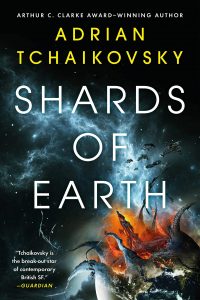Gardner Dozois Reviews Clarkesworld
 Clarkesworld 6/17, 7/17, 8/17, 9/17, 10/17, 11/17, 12/17
Clarkesworld 6/17, 7/17, 8/17, 9/17, 10/17, 11/17, 12/17
The last half of the year was uneven for Clarkesworld; while a few of the issues were unexciting, they also published some of the year’s best stories along the way.
The June Clarkesworld was another good issue, with three strong stories, “My Dear, Like the Sky and Stars and Sun” by Julia K. Patt, which follows the owner of a shop that sells quasi-legal bionic body-modifications as she deals with a strange new customer; “The Ways Out” by Sam J. Miller, which portrays the struggle of mutant children with bizarre opportunities to get by in a continuous-surveillance society that regards them as potential menaces; and “Neptune’s Trident” by Nina Allen, a melancholy post-holocaust tale about a woman in a small village of survivors trying to conceal the fact that her lover has a sickness that the other villagers consider to be contagious.
Strongest stories in the July Clarkesworld are “The Bridegroom” by Bo Balder, about a young man reluctantly taking his place in a generations-old tradition to which he’s expected to devote the rest of his life; “Travelers” by Rich Larson, a grisly techno-horror piece about a woman waking from suspended animation before she’s intended to, in the middle of a colonizing starship’s voyage to a distant planet; and “The Significance of Significance” by Robert Reed, following the life of a young woman who believes that the entire universe as we know it is an elaborate simulation.
The August Clarkesworld is a bit weaker, but does contain worthwhile work, such as “Twisted Knots” by D.A. Xiaolin Spires (the second story Clarkesworld has published this year about the problems involved in using a 3D printer to print meat), “In the Blind” by Sunny Moraine, and “The Stone Weta” by Octavia Cade.
The strongest story in the September Clarkesworld, and one of the best stories to appear in the magazine all year, is “Pan-Humanism: Hope and Pragmatics” by Jess Barber & Sara Saab. Here they join forces to tell a story of star-crossed love, love that remains unrequited for many years – and of how to rebuild a troubled world. This is one of the few stories this year that, rather than wallowing in hopelessness and despair over the climate changes we’re undergoing now and the even more major ones to come, explores ways that we might come to terms with change and build a viable human future. Also good in September is “The Secret Life of Bots” by Suzanne Palmer, which follows a stalwart maintenance robot as it battles a powerful predator infesting – and endangering – a starship on a desperately important mission.
The October Clarkesworld features a strong and creepy story, “The Last Boat-Builder of Ballyvoloon” by Finbarr O’Reilley, which takes us to a future in which the seas have been rendered off-limits to humans by an all-too-plausible human-created menace as frightening as any horror out of Lovecraft. Also good here is “The Sum of Her Expectations” by Jack Skillingstead, which shows us a woman willing to go to extremely dangerous lengths to attempt to rescue her AI, which is stranded on a hostile – and forbidden – alien planet.
The November Clarkesworld is somewhat weaker. Strongest story here is probably “Who Won the Battle of Arsia Mons” by Sue Burke, an enjoyable story about a Battle Bots-style combat being fought out on Mars by small, remote-controlled robots. Also interesting, although somewhat unlikely, is “Praetya Plastics” by D.A. Xiaolin Spires, in which all the plastic being continuously dumped into the sea eventually evolves to become alive and sentient.
After a strong year, Clarkesworld unfortunately closes out 2017 with a weak December issue. Best story here is probably “The Rains of Mars” by Natalia Theodoidou, about a woman having an emotional meltdown that eventually leads to a psychotic break. It’s well-crafted, but didn’t really need to be science fiction at all. Also interesting is “Crossing Lasalle” by Lettie Prill, about someone desperate enough to upload their consciousness into a computer that they’re willing to take big risks to achieve that goal; unfortunately, since they have no really compelling reason for needing to do this, it’s hard to build up a lot of sympathy about whether they succeed or not.
Gardner Dozois was the editor of Asimov’s Science Fiction magazine for almost twenty years, and also edits the annual anthology series The Year’s Best Science Fiction, which has won the Locus Award for Best Anthology more than any other anthology series in history, and which is now up to its Thirty-Fourth Annual Collection. He’s won the Hugo Award fifteen times as the year’s Best Editor, won the Locus Award thirty-one times, including an unprecedented sixteen times in a row as Best Editor, and has won the Nebula Award twice, as well as a Sidewise Award, for his own short fiction, which has been most recently collected in When the Great Days Come. He is the author or editor of more than a hundred books, including a novel written in collaboration with George R.R. Martin and Daniel Abraham, Hunter’s Run, and, in addition to many solo anthologies, the anthologies, Songs of the Dying Earth, Warriors, Dangerous Women, and Rogues, all co-edited with George R.R. Martin, the last two of which were New York Times bestsellers. Coming up is a major solo fantasy anthology, The Book of Swords. He has been inducted into the Science Fiction Hall of Fame, and won the Skylark Award for Lifetime Achievement in Science Fiction. Born in Salem, Massachusetts, he now lives in Philadelphia, Pennsylvania.
This review and more like it in the February 2018 issue of Locus.








